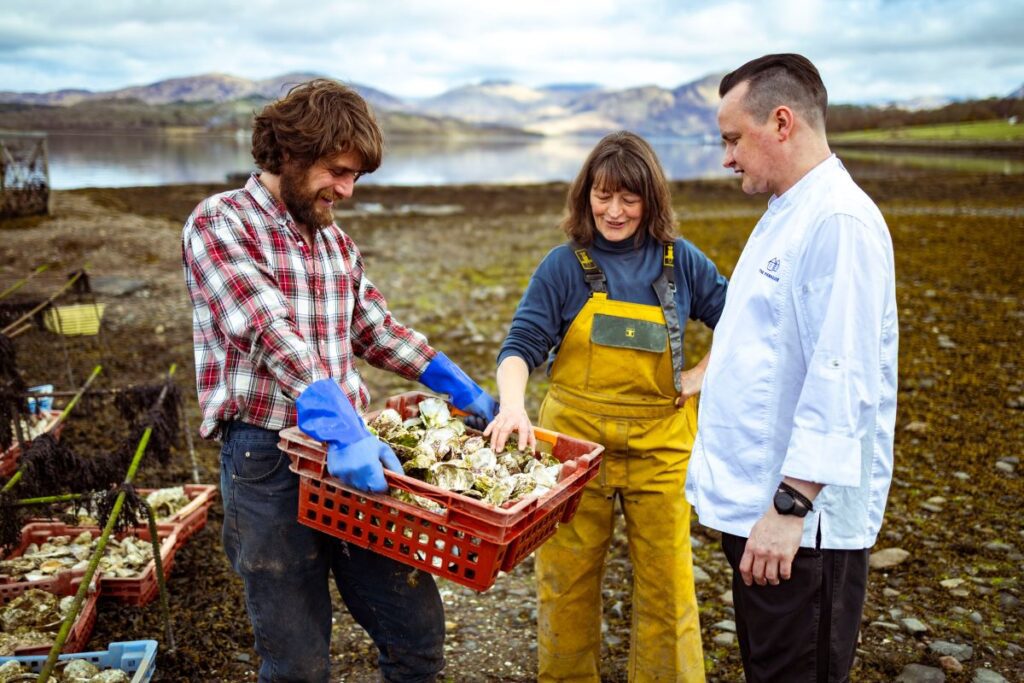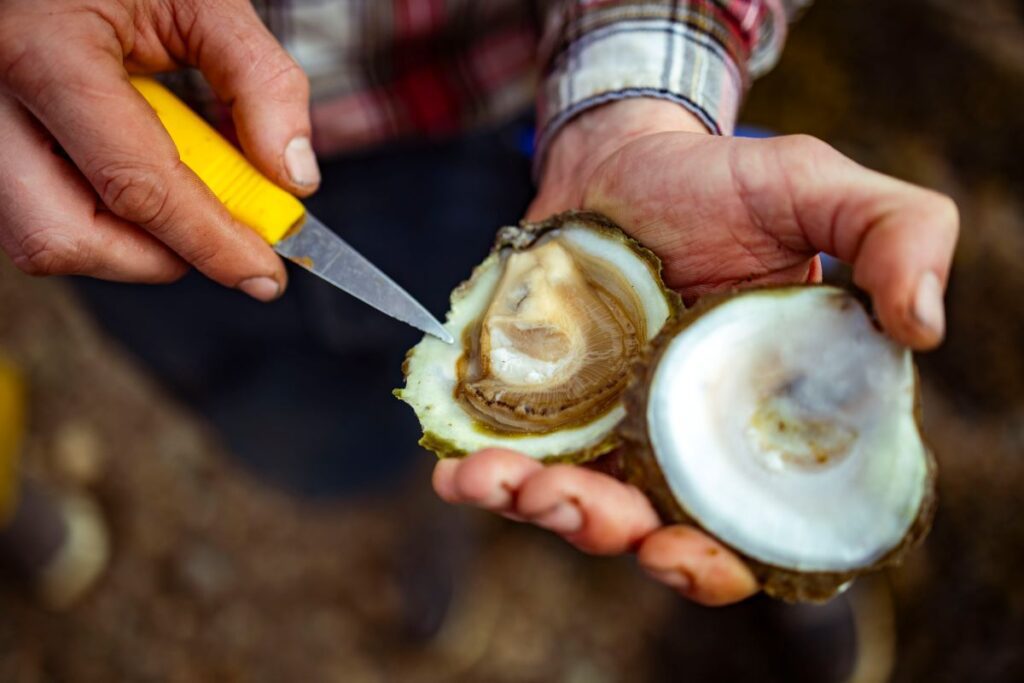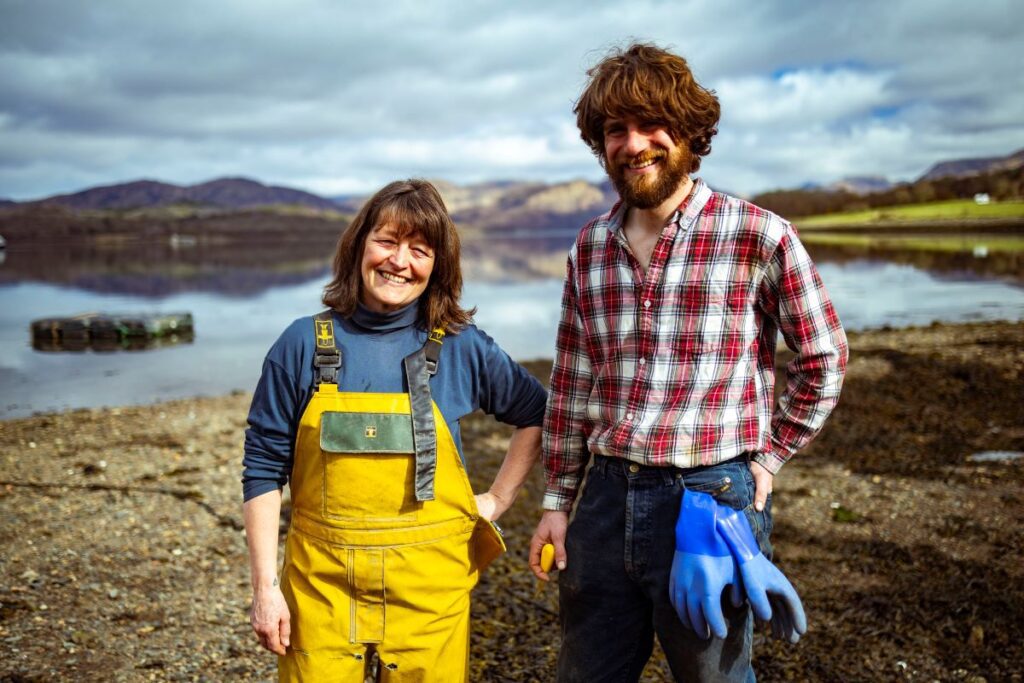
Producer’s Corner: Judith Vajk, Caledonian Oyster Company
Judith Vajk has been harvesting Pacific oysters from Loch Creran near Oban for 30 years.
Brought up in Pethshire, Judith didn’t think much about food until she moved to Paris aged 21. It was while in France her eyes were opened to the world of food, and she tried her first oyster.
Her and her late husband Hugo started oyster farming on Herm Island, in the Channel Islands before deciding to move to Scotland where they started the Caledonian Oyster Company.
‘I was brought up near Blairgowrie and Dunkeld and didn’t think much about food until I moved to be an au pair in Paris, when I was 21,’ she said.
‘It really opened my eyes, there was fantastic wine with every meal, and lovely bread.
‘I got to try international cuisine like Vietnamese and Moroccan foods and of course, I tried oysters for the first time.
‘I started the business with Hugo, my husband who I met and fell in love with in France when I was in my twenties.
‘We started oyster farming from scratch on Herm Island, in the Channel Islands.
‘We happily farmed oysters there for 10 years but only moved to Scotland when our children reached an age where they would need to go to boarding school in Guernsey.
‘We knew an oyster farmer on Loch Creran wanted to retire, as part of our business was selling part growing oysters, and a lot of our customers were in Scotland.’
Loch Creran proved to be the perfect place to grow Pacific oysters – a sheltered spot, the oysters are protected from the full wrath of the sea – and Judith quickly became known as Oban’s very own ‘Oyster Lady’.

Credit: Pierhouse Hotel / James Anderson (NorthColour)
‘Loch Creran is such a sheltered spot, and the oysters are protected from the full wrath of the sea, which means the wire tables are less likely to move and get tipped over,’ Judith said.
‘The farm is close to the stunning Morven Peninsula, and I can see North Shian on the other side of the loch.
‘The oysters are filter feeders so it is important that sea water recycles into the loch. It is a beautiful spot, and it is very quiet and peaceful.’
But the location is not without its challenges. With the warm, wet weather there are midges to contend with and if crabs or starfish get into the oyster net bag, they soon munch through the babies.
Judith starts growing the tiny oysters when they are the size of a pinky nail, at around three months old.
She gets the tiny spat oysters from a hatchery in Guernsey, and places them in mesh bags on wire trestle tables out from the shore where they are checked at every tide to make sure the bags are still attached.
They are harvested when they reach 60g at around three or four years old.
‘Pacific oysters (Magallana gigas) have a much milder taste than natives (Ostrea edulis), which have a stronger taste and firmer meat,’ she said.
‘Some people do not like the flavour of natives, although both taste salty and have the flavour of the sea, I think the Pacifics have a much softer texture.
‘I start growing tiny oysters when they are only about the size of your pinky nail, around three months old.
‘I get the tiny spat oysters from a hatchery in Guernsey, and place them in fine mesh bags on wire trestle tables out from the shore made from rebar.
‘Initially, you want them to be feeding as much as possible. They are checked at every tide to make sure the bags are still attached, and they are growing well.
‘At six months, they are brought ashore and given their first grading. The idea is to keep similarly sized oysters together. They are put back in nets and then return to the beds to grow more.
‘We grade them around every six months to a year and harvest them when they reach 60 grams, around three or four years old.
Judith now has more than two million oysters and during the busy season, will sell around 5,000 a week.

Credit: Pierhouse Hotel / James Anderson (NorthColour)
In the summer when the area is busy with tourists, Judith has an oyster honesty box at the end of the road, where people can buy oysters for £1 a shell. Her favourite way to enjoy her oysters is with shallots and red wine vinegar, a classic Mignonette.
And what’s the best way to shuck an oyster?
‘I would advise always putting it on a tea towel on a table. I think it’s a far safer way to do it. This gives you a bit of purchase, and then you put your knife in it,’ expert Judith said.
‘The blade goes in at the pointed end until you feel it stick, then give it a twist as if you’re turning a key, and the hinge will pop right open.
‘With the hinge facing you, the muscle that holds the two shells together is always on the right-hand side. You sweep your knife along and cut the top shell and then the bottom shell.
‘It is ready to eat, but don’t swallow it whole; give it a couple of chews. That is a far nicer way to eat it to get the full flavour of it.’
Due to popular demand, Judith and her son, Angus ‘Oyster Laddie’, have decided to branch out to offer this new tourist experience, offering guests the opportunity to learn more about farming oysters.
Working around the vagaries of weather and tides, guests will be able to discover more about farming oysters at the Caledonian Oyster Farm, on Loch Creran. They will then be shown how an expert shucks an oyster, before being invited to have a go themselves.
The Caledonian Oyster Company shore-based tour costs £42 per person and lasts approximately one hour; wellies are not essential, but guests are advised to wear sensible footwear.
At the end of the tour, guests sample a delicious oyster flight, featuring three toppings: lemon juice, Isle of Mull Seaweed Hot Sauce, and a classic mignonette sauce.
Read more Producer’s Corner here.
Subscribe to read the latest issue of Scottish Field.
TAGS

